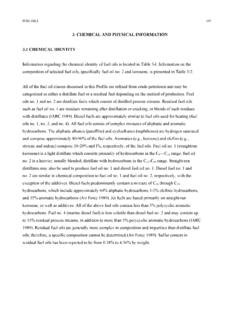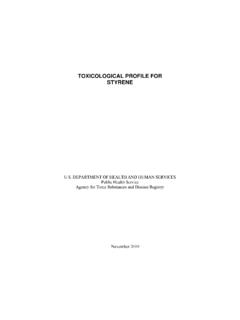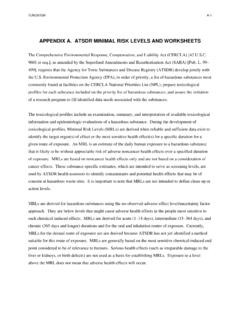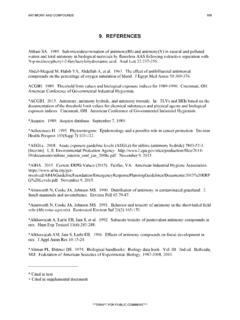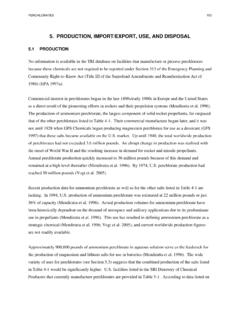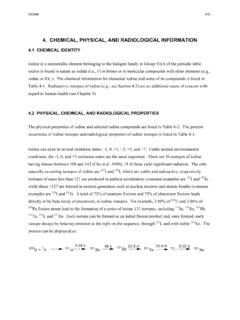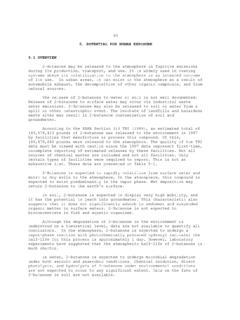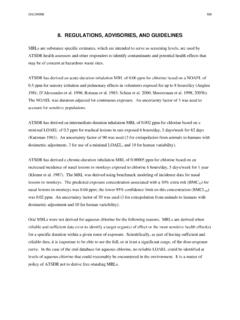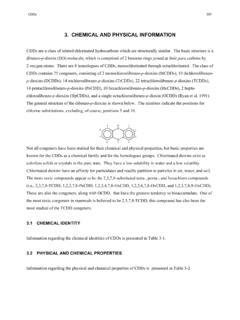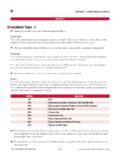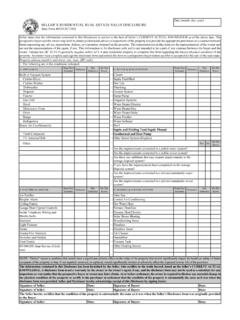Transcription of Chemicals, Cancer, and You
1 Chemicals, Cancer, and You There are many risk factors for cancer: age, family history, viruses and bacteria, lifestyle (behaviors), and contact with (touching, eating, drinking, or breathing) harmful substances. More than 100,000. chemicals are used by Americans, and about 1,000 new chemicals are introduced each year. These chemicals are found in everyday items, such as foods, personal products, packaging, prescription drugs, and household and lawn care products. While some chemicals can be harmful, not all contact with chemicals is dangerous to your health. This booklet will discuss the relationship between contact with harmful chemicals, cancer, and you. It will explain risk factors (things that make you likelier to get cancer), how cancer develops, and how contact with (exposure to) chemicals affects your body. Agency for Toxic Substances and Disease Registry Division of Health Assessment and Consultation CS218078-A. 1. Chemicals, Cancer, and You Some factors that increase your risk of developing cancer include behaviors such as smoking, heavy alcohol Examples of Known Human Carcinogens consumption, on-the-job exposure to chemicals, radiation and sun exposure, and some viruses and bacteria.
2 When all these risks are considered together, the role of chemical Asbestos exposures in causing cancer is small and, as of now, not very clear. Scientists know very little about how contact with Arsenic most chemicals causes cancer. Benzene Substances known to cause cancer are called carcinogens. Coming into contact with a carcinogen does not mean you Beryllium will get cancer. It depends on what you were exposed to, how often you were exposed, and how much you were exposed to, among other things. Vinyl chloride An early link between cancer and a chemical was found in the late 1700s. An English physician noted that a large number of chimney sweeps had cancer of the scrotum due Examples of Possible Human Carcinogens to exposure to soot, which contains chemicals known as polycyclic aromatic hydrocarbons. Since then, many more Chloroform chemicals have been identified as known or suspected causes of cancer. Today, much of what we know about DDT. chemicals causing cancer in humans we have learned from workers exposed at their jobs.
3 What Is Cancer? The cell is the basic building block of all living things. All cells normally grow and divide (multiply) to replace old cells to keep the body healthy. A cell becomes cancerous when it grows quickly and uncontrollably. In most cancers, this process leads to the growth of tumors. A tumor is an abnormal growth of tissue resulting from uncontrolled cell growth. Tumors are either benign or malignant. Benign tumors are not cancer. Cells from benign tumors do not spread to other parts of the body. Benign tumors are not usually life threatening. Malignant tumors are cancer. Cancer cells can spread to other tissues and organs near the tumor. They can also spread to other sites in the body through the bloodstream or lymphatic system . This spreading is called metastasis. People of all ages get cancer, but it is most common in people older than 55. One of every three people will get cancer at some point in his/her life. Though we know more about some cancers than others, in most cases we don't know why or how a normal cell changes into a cancer cell.
4 We do know that changes occur in a series of steps, which usually takes a long time. The time from the first cell change to the time the cancer is detected is called the latency period. 2. Chemicals and Cancer Understanding which chemicals cause which cancers is one Some chemicals are known to cause cancer in animals, but of our greatest scientific challenges. People are exposed to they have not been proven to cause cancer in humans. trace amounts of many chemicals every day. These everyday These chemicals are reasonably anticipated to cause exposures are usually too small to cause health problems. cancer in humans and are sometimes called possible human carcinogens. Chloroform, DDT, formaldehyde, and Exposure to chemicals in the outdoors, at home, and at polychlorinated biphenyls (PCBs) are examples of possible work may add to your chances of getting cancer. Certain human carcinogens. chemicals, including benzene, beryllium, asbestos, vinyl chloride, and arsenic are known human carcinogens, Getting cancer from a chemical depends on the following: meaning they have been found to cause cancer in humans.
5 A person's risk of developing cancer depends on how much, The kind of chemical you were exposed to, how long, how often, and when they are exposed to these How much of the chemical you were in contact with, chemicals. When you are exposed is important because a How long the contact lasted, small exposure in the womb, for example, may be more How often you were exposed, serious than a small exposure as an adult. The genes that When you were exposed, you inherit from your parents also play a role. How you were exposed, and Your general health. 3. Exposure at Work Though everyday exposures to chemicals are usually too low to cause harmful health problems, exposure in the workplace can be more serious. Chemical exposures in the workplace can happen at high levels and over long periods of time. That is why some jobs require that employees wear protective clothing and equipment and/or respirators. Companies are supposed to notify their employees of a potential danger to their health.
6 Remember, exposure to harmful substances in the workplace can be very different from exposure in other settings. Cancers Associated with Various Occupations or Occupational Exposure Cancer Substances or Processes Lung Arsenic, asbestos, cadmium, coke oven fumes, chromium compounds, coal gasification, nickel refining, foundry substances, radon, soot, tars, oils, silica Bladder Aluminum production, rubber industry, leather industry, 4-aminobiphenyl, benzidine Nasal cavity and Formaldehyde, isopropyl alcohol sinuses manufacture, mustard gas, nickel refining, leather dust, wood dust Larynx Asbestos, isopropyl alcohol, mustard gas Pharynx Formaldehyde, mustard gas Mesothelioma Asbestos Lymphatic and Benzene, ethylene oxide, hematopoietic herbicides, x-radiation system Skin Arsenic, coal tars, mineral oils, sunlight Soft-tissue sarcoma Chlorophenols, chlorophenoxyl herbicides Liver Arsenic, vinyl chloride Lip Sunlight Sources: American Cancer Society Fact Sheet Occupation and Cancer.
7 International Agency for Research on Cancer. 4. How Chemical Exposure Affects the Body The human body has defenses to guard against all sorts of harmful exposures, including those that may lead to cancer. When something enters your body, it often goes through a process that allows the body to more easily use or get rid of it. This process is called metabolism. Depending on how a chemical is processed, or metabolized, in your body, three types of carcinogens exist: Chemicals that can cause cancer (direct acting carcinogens), Chemicals that do not cause cancer unless they are changed when they are metabolized (procarcinogens), and Chemicals that do not cause cancer by themselves but can act with another chemical to cause cancer (cocarcinogens). Damage to DNA in cells can lead to cancer. However, cells can often repair DNA damage. If the damage is extreme, the cells may die. Unrepaired DNA damage can lead to mutations, or changes, in genes, and mutations in certain genes can cause cancer.
8 You can also inherit mutations. Because cancer has a long latency period, determining which exposure, if any, may have led to a mutation is difficult. Therefore we know very little about specific causes of cancers. How Cells Respond to Chemical Injuries 5. Cancer Clusters Because many cancers are common diseases, they occur Cancer clusters are rare, especially those that are linked to quite often in communities. We expect to find several cases an environmental exposure. When a group of cancers is of cancer in any given neighborhood or workplace. Because linked to an environmental exposure, it is usually because of most cancers are tracked in national databases, we have the conditions below: a good idea of how many cases to expect in a certain area over a certain amount of time. However, multiple cases of Many more cases than expected of one specific type of cancer in a neighborhood can cause a great deal of concern cancer or related cancers have been found. to residents. People may suspect there is a cancer cluster The cancer is found in an age group in which it is not in their community if several people have cancer.
9 They may usually found. also suspect something in the environment is the cause. The type of cancer is rare. Scientific evidence supports the link between the A cancer cluster is when more people within a specific chemical in question and cancer. geographic area have the same type of cancer or related cancers than would normally be expected over a certain time period. However, what appears to be a cluster may Identifying just how much of a cancer-causing substance actually reflect the expected number of cancer cases within a community has been exposed to is challenging. For the group or area, or it may be due to chance alone. Clusters example, many hazardous waste sites contain more than may be suspected if the cancer found is normally rare. one chemical, which makes relating health outcomes to a For example, mesothelioma is found only in people who single chemical exposure difficult. have been exposed to asbestos; therefore, many cases of mesothelioma were found in communities with asbestos Remember that not all chemicals are harmful.
10 Also, just exposure. because a chemical is in the environment near where you live or work does not mean that it has entered your body. To learn more about cancer clusters, environmental health concerns, and toxic chemicals where you live or work, go to clusters/. 6. Risk Factors for Cancer More than 200 types of cancer have been identified. Many The most important risk factors are risk factors such as age, genetics, or lifestyle choices can add to your chance of getting cancer. Cancer is usually not Age: Although people of all ages can get cancer, older caused by only one risk factor but by several of them. The people are at greater risk. more risk factors you have, the higher your risk of getting Genetics: Your family history may put you at risk for cancer. cancer. If you or someone in your family had a certain type of cancer, you may be more at risk for that type of cancer. Genetics play a large role for many cancers, such as breast cancer and colon cancer. Behaviors: Tobacco use and exposure to the sun or other sources of UV radiation are risk factors for cancer.
